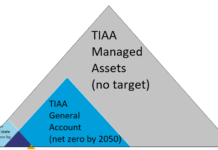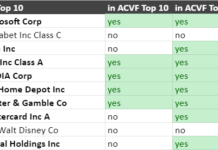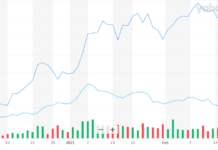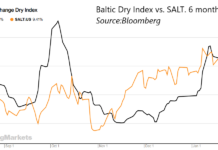Tom Konrad CFA
Rules of Investing
Warren Buffett says “The first rule of Investing is don’t lose money; the second rule is don’t forget rule #1.”
Jim Hansen at Ravenna Capital Management and publisher of the Master Resource Report about oil and other energy news has a “prime directive” (a la Star Trek) about oil prognostication which is “never predict prices.”
These rules have to be taken metaphorically, not literally.
Buffett’s rule is too general to be useful. I take his message to mean that care to avoid losses is more effective than chasing gains. That’s sage advice. Last year I showed how a stock market investor gains more by being out of the market on the worst months than he gains by being in the market on the best months.
What Buffett’s rule does not tell us is how not to take losses. “Don’t lose money” is a great bumper sticker or pithy saying to keep on your desk, but not of much practical value taken alone. All investments hold risk, and you might lose money in anything. If we took him literally, we’d never invest in anything.
As for Jim Hansen’s “prime directive,” I agree with the subtext: If you predict the oil price, you will be wrong. In fact, I think this prime directive applies to a lot more than just oil: if you try to predict price in any somewhat efficienct market, you will be wrong. But again, the directive is far from useful in investing practice. Investing is all about making predictions. If I buy any security, be it a stock, a bond, a commodity such as oil, or a mutual fund, I’ve made a prediction about price. I’ve essentially predicted that the price of the security (plus any income from it) will go up fast enough to meet whatever goals I have for the investment.
A Rule You Can Use
As an investor, I have to predict price or stop being an investor. Yet I know that my prediction will be wrong, and I want to be careful not to lose money. So my rule is:
Be Prepared to be Surprised
Any time you make an investment, you’re making a prediction about price. You can be surprised in a good way (your stock goes up 200% when you only thought it would go up 50%), or you can be surprised in a dangerous way (the company goes bankrupt). We don’t need to prepare for the good surprises, but we do need to prepare for the dangerous ones. Investors who tell themselves that something bad isn’t going to happen may be right a few times, but the more times they are right, the more confident they become that they can ignore risks. Usually sooner, but sometimes later, they are surprised, and they lose everything because there was no contingency plan.
Surprises Everywhere
The market is not the only place where this rule applies.
For example, if you are single, and want a date, be prepared to be surprised. Suppose you do find that tall, dark, and handsome doctor or blond bombshell who always laughs at your jokes and who seems to have every item on your wish-list. The tall, dark and handsome doctor might not be forthcoming with the fact that he’s a mini-Tiger Woods: i.e. he has two kids, a wife and a few other women on the side. The blond bombshell could be laughing at your jokes because she is sizing up your paycheck and calculating her future alimony payment.
When anything seems too good to be true, it probably is.
Preparation beats Prediction
Dating may be complex; but investing is simpler. There’s only one type of bad surprise: surprises that lose you a lot of money. Be prepared for the catastrophic event even though you’re certain that there is no way it could happen.
You did not need to predict the 2008 stock market meltdown to be prepared. When the Dow was over 12,000, you could have bought puts betting it would fall below 10,000 for pennies on the dollar, enough to cover all your losses when the Dow hit 9,000, and even have a net gain when it fell below 8,000. Buying those puts is preparation. A stop-loss order that automatically sells a position if it falls to far is also preparation, although they open you up to liqidity risks during market turmoil, as we saw when the Dow fell 9% and then rebounded on May 6th. A watchful eye on the market and a willingness to sell at a small loss can also protect you from much worse losses, but only if you are a dedicated market watcher and have thought through what a disaster might look like before it happens.
How do you know what a disaster might look like? The exercise I did in February is a start: Try imagining what it would take to make you lose all (or most) of your money over the next year. Once you’ve dreamed up as many such doomsday scenarios as you can, you can change your portfolio to reduce your vulnerability to the most worrying scenarios. If you’ve already considereed what a potential investing disaster might look like before it happens, you’ll be much more ready to sell and cut your losses while it’s still developing than if you had never given a second thought as to what it might look like. You won’t think of everything, but if the news or market action does not fit with a scenario you’ve thought of, it’s time to start expecting the worst.
Conclusion
The most important way to prevent market surprises from becoming large portfolio losses is to keep an open mind. While we can’t think of everything that might go wrong and cause our stocks to tank, a prudent investor remembers that there are always dangerous possibilities. Expect to be surprised, and plan defensive strategies. If we don’t expect to be surprised, we’re much more likely to ignore the early warning signs of a catastrophic market move, thinking that they are just momentary aberrations that will soon correct themselves.
We must predict price to invest, so we need to recognize quickly when our predictions go wrong. Being prepared to be surprised will help keep us in compliance with Buffett’s first rule: “Don’t lose money.”
DISCLAIMER: The information and trades provided here are for informational purposes only and are not a solicitation to buy or sell any of these securities. Investing involves substantial risk and you should evaluate your own risk levels before you make any investment. Past results are not an indication of future performance. Please take the time to read the full disclaimer here.









In this market I would add a second rule. “Don’t own unprofitable companies that have less than 12 to 18 months of cash on their balance sheets, including planned capital spending.”
I absolutely agree with your rule John. While a strong balance sheet was not essential before 2008, it has been since than, and I don’t see this changing anytime soon.